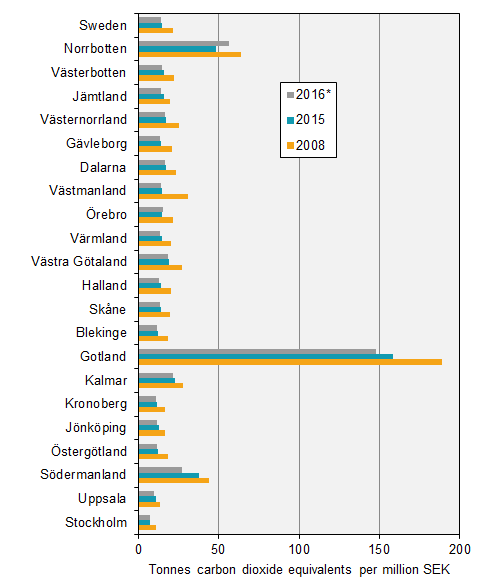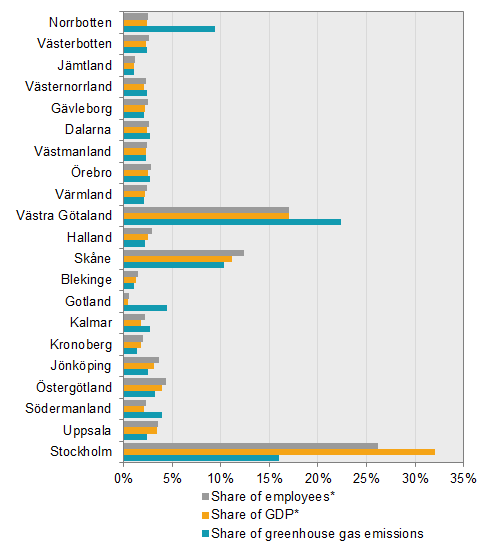Environmental accounts – Emissions to air 2016, regional statistics
Major regional differences remain in greenhouse gas emission intensities
Statistical news from Statistics Sweden 2018-11-15 9.30
Greenhouse gas emissions in Sweden in relation to GDP, also called emission intensity, decreased between 2015 and 2016. This indicates a more efficient production of goods and services in the Swedish economy. Regional differences are significant. Gotland County is the most emission intensive county and Stockholm is the least emission intensive county. Gotland and Södermanland counties accounted for the largest improvements in emission intensity between 2015 and 2016.
Today, Environmental accounts at Statistics Sweden publishes 2016 regional emissions to air by industry at national, regional and municipal level. Applying population, labour market and economic statistics enables relating them to emissions to air. This form highlights the relationship between population and air emissions, the contributions that companies make towards the economy, and companies’ impact on the environment.
The statistics are presented in the form of emissions, emission intensities and environmental economic profiles and follow the framework of the national accounts. This means the emissions are linked to the economic activity responsible for the emissions. This does not necessarily imply that the emissions, in fact, took place in a specific region, but rather that the actor responsible for the emissions is located there.
Emission intensity by county
Gotland County decreased its emission intensity the most among counties between 2015 and 2016. However, Gotland remains the most emission intensive county. The bulk of greenhouse gas emissions by the economy in Gotland stems from the manufacture of goods with large process emissions, but the largest contributions to the economy in Gotland are provided by the service industry and public sector.
Emission intensity between 2015 and 2016 also decreased significantly in Södermanland County. Emission intensity in Norrbotten County increased in 2016 compared with 2015. However, emission intensity in the county is still lower than in 2008. Stockholm was the least emission intensive county in 2016.

* The 2016 gross regional product is preliminary.
Environmental economic profile by county
A county’s environmental economic structure can be described at a general level using an environmental economic profile. The profile shows relationships such as each county’s share of Sweden’s GDP and emissions.
In many counties, the share of greenhouse gas emissions are roughly the same size as the share of employees and the share of gross domestic product (GDP). Västra Götaland, Norrbotten, Södermanland and Gotland counties’ emission intensive profiles show a larger share of greenhouse gas emissions than the share of employees and GDP. This is due to the presence of emission intensive industries and numerous shipping companies in these counties.
Västra Götaland County has high levels of output of both goods and services. This leads to a high share of employees, contributions to GDP and emissions to air of greenhouse gases. In Norrbotten County, there is a smaller share of employees and gross regional product, but the share of greenhouse gas emissions is high. This is due, in part, to low levels of employment in industries with high emissions levels.
In Stockholm County, there is a high share of employees and also contributions to GDP. The largest industries in Stockholm County are in the services sector and have relatively low emissions to air of greenhouse gases.

* The 2016 gross domestic product and employees are preliminary data.
Definitions and explanations
The Environmental Accounts are compiled according to the framework of the System of Environmental and Economic Accounts (SEEA) and show national environmental statistics and economic statistics in the same framework using NACE industry classification. Environmentally-related statistics linked to the system of national accounts enable analysis of connections between the Swedish economy and the impact of each industry on the environment. Emissions from international bunkers, that is, international aviation and navigation arriving and refuelling at Swedish airports and harbours, are included. Emissions and removals from land use and land use change (LULUCF) and carbon capture and storage (CCS) are not included.
Regional air emission accounts per NACE industry enable analyses of Swedish regional economy, emissions’ impact on the environment and environmental impact on the economy. Indicators, such as different industries’ production process streamlining, can be evaluated based on emissions by value added. These statistics are explained in more detail in the Environmental Accounts Statistical Report 2017:2 Regional Environmental Accounts 2008–2015.
Regional statistics on all greenhouse gas emissions and a number of air pollutants are available in the Statistical Database. Excel spreadsheets are also available for download on Statistics Sweden’s website, and include data and figures on greenhouse gas emissions and emissions intensities by value added and by employees.
The regional breakdown is at county, municipality and NUTS level.
These statistics on air emissions are reported based on a production perspective. Emissions are reported in the industry where emissions occur. Indirect emissions from imports and other consumption of goods and services are not included.
Regional statistics on emissions to air reported by the Swedish EPA refer to emissions within the territory, that is, emissions that occur within the boundaries of each region. This means that the Swedish EPA statistics should be used to monitor air pollution levels in specific areas.
Swedish Environmental Protection Agency, Swedish Pollutant Release and Transfer Register
Next publishing will be
The next statistical news on national quarterly emissions to air up to and including the third quarter of 2018 is scheduled for publication on 2019-01-31 at 09:30.
The next statistical news on national annual emissions to air 2008–2017 is scheduled for publication on 2019-03-28 at 09:30.
The next statistical news on regional annual emissions to air 2008–2017 is scheduled for publication on 2019-11-14 at 09:30.
Statistical Database
More information is available in the Statistical Database
Feel free to use the facts from this statistical news but remember to state Source: Statistics Sweden.
